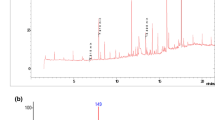Abstract
Ten strains of the genus Lactococcus were examined for their ability to remove bisphenol A [2, 2-bis(4-hydroxyphenyl)propane; BPA], which is known as an endocrine disrupter. Nine strains of the lactococci tested could remove BPA from media during growth, although the removal ratio was below 9%. When BPA was incubated with lyophilized cells of lactococci for 1 h, the concentration of BPA in the media was decreased by 9–62%. Especially, the highest removal ratio of BPA was observed for Lactococcus lactis subsp. lactis 712. The lactococci could adsorb BPA but not degrade it, because the lactococci maintained the ability to remove BPA from the medium after autoclaving. When the lyophilized cells of L. lactis subsp. lactis 712 were also incubated with six analogues of BPA, they effectively adsorbed hydrophobic compounds such as 2, 2′-diphenylpropane and bisphenol A dimethylether. The BPA-adsorbing ability of lactococci could be due to the hydrophobic binding effect. The removal ratio of BPA by L. lactis subsp. lactis 712 was increased after treatment with sodium dodecyl sulfate and decreased after digestion with trypsin. These results suggest that the hydrophobic proteins on cell surface may be involved in the BPA-adsorbing ability of lactococci.
Similar content being viewed by others
References
Fukuda T, Uchida H, Takashima Y, Uwajima T, Kawabata T, Suzuki M (2001) Degradation of bisphenol A by purified laccase from Trametes villosa. Biochem Biophys Res Commun 384:704–706
Hirano T, Honda Y, Watanabe T, Kuwahara M (2000) Degradation of bisphenol A by the lignin-degrading enzyme, manganese peroxidase, produced by the white-rot basidiomycete, Pleurotus ostreatus. Biosci Biotechnol Biochem 64:1958–1962
Hosoda M, Hashimoto H, Morita H, Chiba M, Hosono A (1992a) Antimutagenicity of milk cultured with lactic acid bacteria against N-methyl-N′-nitro-N-nitrosoguanidine. J Dairy Sci 75:976–981
Hosoda M, Hashimoto H, Morita H, Chiba M, Hosono A (1992b) Studies on antimutagenic effect of milk cultured with lactic acid bacteria on the Trp-P-2 induced mutagenicity to TA98 strain of Salmonella typhimurium. J Dairy Res 59:543–549
Hosono A, Tono-oka T (1995) Binding of cholesterol with lactic acid bacteria cells. Milchwissenschaft 50:556–560
Kang JH, Kondo F (2002) Bisphenol A degradation by bacteria isolated from river water. Arch Environ Contam Toxicol 43:265–269
Kawamura Y, Koyano Y, Takeda Y, Yamada T (1998) Migration of bisphenol A from polycarbonate products (Japanese). J Food Hyg Soc Jpn 39:206–212
Kimoto H, Kurisaki J, Tsuji NM, Ohmomo S, Okamoto T (1999) Lactococci as probiotics strains: adhesion to human enterocyte-like Caco-2 cells and tolerance to low pH and bile. Lett Appl Microbiol 29:313–316
Kimoto H, Ohmomo S, Okamoto T (2002) Cholesterol removal from media by lactococci. J Dairy Sci 85:3182–3188
Kimoto H, Nomura M, Kobayashi M, Mizumachi K, Okamoto T (2003) Survival of lactococci during passage through mouse digestive tract. Can J Microbiol 49:707–711
Krishnan AV, Stathis P, Permuth SF, Tokes L, Feldman D (1993) Bisphenol A: an estrogenic substances is released from polycarbonate flasks during autoclaving. Endocrinology 132:2279–2286
Lobos JH, Leib TK, Su TM (1992) Biodegradation of bisphenol A and other bisphenols by a gram-negative aerobic bacterium. Appl Environ Microbiol 58:1823–1831
Mergler M, Wolf K, Zimmermann M (2004) Development of bisphenol A-adsorbing yeast by surface display of the Kluyveromyces yellow enzyme on Pichia pastoris. Appl Microbiol Biotechnol 63:418–421
Nagel SC, von Saal FS, Thayer CA, Dhar MG, Boechler M, Welshons WV (1997) Relative binding affinity-serum modified access (RBA-SMA) assay predicts the relative in vivo bioactivity of the xenoestrogens bisphenol A and octylphenol. Environ Health Perspect 105:70–76
Ohko Y, Ando I, Niwa C, Tatsuma T, Yamamura T, Nakashima T, Kubota Y, Fujishima A (2001) Degradation of bisphenol A in water by TiO2 photocatalyst. Environ Sci Technol 35:2365–2368
Peltonen K, El-Nezami H, Haskard C, Ahokas J, Salminen S (2001) Aflatoxin B1 binding by dairy strains of lactic acid bacteria and bifidobacteria. J Dairy Sci 84:2152–2156
Ronen Z, Abeliovich A (2000) Anaerobic–aerobic process for microbial degradation of tetrabromobisphenol A. Appl Environ Microbiol 66:2372–2377
Sakai K, Yamanaka H, Moriyoshi K, Ohmoto T, Ohe T (2003) Degradation of bisphenol A by microorganisms isolated from sea water (Japanese). Kagaku to Kogyo 77:156–161
Sakurai A, Toyoda S, Sakakibara M (2001) Removal of bisphenol A by polymerization and precipitation method using Corpinus cinereus peroxidase. Biotechnol Lett 23:995–998
Sakuyama H, Endo Y, Fujimoto K (2003) Oxidative degradation of alkylphenols by horseradish peroxidase. J Biosci Bioeng 96:227–231
Sakuyama H, Endo Y, Fujimoto K (2004) Degradation of alkylphenols by peroxidase with linoleic acid hydroperoxides (Japanese). J Environ Chem 14:567–573
Spivack J, Leib TK, Lobos JH (1994) Novel pathway for bacterial metabolism of bisphenol A. J Biol Chem 269:7233–7239
Tanabe T, Suyama K, Hosono A (1994) Effect of sodium dodesylsulphate on the binding of Lactococcus lactis subsp. lactis T-80 cells with Trp-P-1. J Dairy Res 61:311–315
Tanaka T, Yamada K, Tonosaki T, Konishi T, Goto H, Taniguchi M (2000) Enzymatic degradation of alkylphenols, bisphenol A, synthetic estrogen and phthalic ester. Water Sci Technol 42:89–95
Tanaka T, Tonosaki T, Nose M, Tomidokoro N, Kadomura N, Fujii T, Taniguchi M (2001) Treatment of model soils contaminated with phenolic endocrine-disrupting chemicals with laccase from Trametes sp. In a rotating reactor. J Biosci Bioeng 92:312–316
Xuan YJ, Endo Y, Fujimoto K (2002) Oxidative degradation of bisphenol A by crude enzyme prepared from potato. J Agric Food Chem 50:6575–6578
Yoshida M, Ono H, Mori Y, Chuda Y, Onishi K (2001a) Oxidation of bisphenol A and related compounds. Biosci Biotechnol Biochem 65:1444–1446
Yoshida T, Horie M, Hoshino Y, Nakagawa H (2001b) Determination of bisphenol A in canned vegetables and fruit by high performance liquid chromatography. Food Addit Contam 18:69–67
Yoshida M, Ono H, Mori Y, Chuda Y, Mori M (2002) Oxygenation of bisphenol A to quinines by polyphenol oxidase in vegetables. J Agric Food Chem 50:4377–4381
Author information
Authors and Affiliations
Corresponding author
Rights and permissions
About this article
Cite this article
Endo, Y., Kimura, N., Ikeda, I. et al. Adsorption of bisphenol A by lactic acid bacteria, Lactococcus, strains. Appl Microbiol Biotechnol 74, 202–207 (2007). https://doi.org/10.1007/s00253-006-0632-y
Received:
Revised:
Accepted:
Published:
Issue Date:
DOI: https://doi.org/10.1007/s00253-006-0632-y




